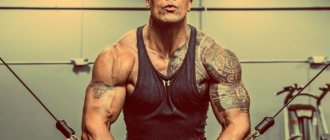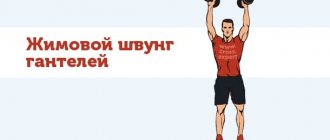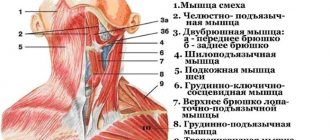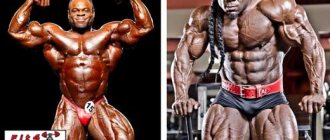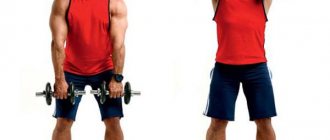Shrugs, or shrugs, are a classic exercise for developing the trapezius muscles located in the upper back. Most athletes prefer to perform shrugs with dumbbells. They can also be done with a barbell, in a machine or on parallel bars. The exercise is suitable for athletes with an above-average level of training who use isolated training of even small muscle groups. For beginners, as a rule, the load that the trapezius receives when performing basic exercises is sufficient.
Working muscles and benefits of exercise
The first step is to determine how shrugs affect the target muscles and what benefits the exercise provides.
The main muscle group that bears the load is the trapezius. Like all back muscles, they are paired. The trapezius muscles are located in the upper back, in the back of the neck. They got their name due to their external resemblance to a quadrangular geometric figure.
The trapezius muscles perform the function of pressing and lowering the shoulder blades, as well as raising the upper limbs. They help us maintain a straight posture and avoid slouching. The upper trapezius muscles also support the shoulders and prevent them from sagging, which allows the arms to rise, fall, and rotate.
Shrugs are performed in various variations, however, in all cases, the main share of the load falls on the upper part of the trapezius muscles, and other muscles (spinal extensor muscles, scapular stabilizer muscles) act as stabilizers and bear an indirect load. In addition to the trapezius muscles and stabilizer muscles, the rhomboid muscles receive load.
Anatomically, the trapezius can be divided into 3 main areas: the top, middle and bottom.
The middle part of the trapezius is pumped when the athlete performs various bent-over rows. The lower beam is developed by lifting weights above the head. And training of the upper muscles of these muscles occurs with the use of shrugs.
Good development of the trapezius muscles provides many benefits that stem from the above functions of this muscle group, namely:
- External increase in the upper body and shoulder width, giving the figure volume, massiveness and relief.
- Increasing strength in compound basic exercises (pull-ups, rows, etc.). In addition, developed trapezius muscles will make it easier for you to perform squats with a barbell on your back, since the barbell will put pressure on the trapezius area and will not cause discomfort.
- Improving the overall tone of the body, improving posture, correcting a stooped figure, strengthening the stabilizing muscles in the area of the shoulder blades.
The exercise is not recommended for people with problems with the spine, cervical spine or shoulder girdle. To begin with, it is better to consult with your doctor. Often performing shrugs using light weights is acceptable for therapeutic purposes.
Excessive weights should not be used in the exercise, as this may reduce the effectiveness of the exercise and remove the target load from the trapezius muscles. To effectively work the trapezius muscles, isolated exposure to them is required. In addition, this creates a large traumatic load on the shoulders and spine.
Execution technique
As already mentioned, the most famous variation is the standing shrug exercise with dumbbells. Let's look at the correct technique for performing this exercise.
Anatomy
The trapezius muscles, unlike the latissimus and rhomboids, are a large complex that normalizes the upper part of the spine. The complex can be divided into 3 main groups:
- Upper - in fact, this is what we are talking about when the appropriate exercises for the trapezius are prescribed. Responsible for raising the shoulders and keeping them in normal condition;
- The middle beam is located under the diamond-shaped ones. Easily activated using a deadlift. Responsible for the “thickness of the back” and bringing the shoulder blades back.
- The lower beam is responsible for bringing the shoulder blades closer to the spine. Usually functions simultaneously with the top one. But for pumping, separate sets of exercises are required.
And what does it mean? Yes, it’s simple - to properly develop the trapezius group, you need not one exercise, but three. A similar situation can be observed, for example, with the pectoral muscles, or to a lesser extent with the triceps.
Why are they needed?
A very relevant question for most athletes. If, regarding bodybuilders, the answer becomes obvious - “aesthetics”, then why pump the trapezius, for people who believe that deadlifts and upper rows provide sufficient load on the entire back.
- First, carry the girl in your arms. Yes, no matter how funny it may seem, even with very strong arms, it is simply impossible to beautifully lift a girl to carry her “to the altar.” It will hang below the level of the press, which will look very unaesthetic.
- Secondly, carry bags from department stores. Have you been working out in the gym for a long time? You're working hard and have already gained a couple of kilograms of weight, but how many bags of food can you carry? And we are not talking about the distance from the store to the trunk, but from the store to home. To ensure that carrying large loads does not cause stress, especially with prolonged static exposure, you need to work on your trapezius.
- Thirdly, appearance. A person who trains hard in the gym (on horizontal bars with uneven bars, does CrossFit, etc.) can get a huge imbalance between the pectoral and back muscles. Outwardly, this does not look very pleasant; it seems that the person constantly has a hunched back and low shoulders. Many people have seen this picture in the gym, but if you look closely at athletic professionals, none of them have drooping shoulders. And all because they are held by trapezoids.
Well, and finally – the quality and position of the spine. As you know, in order to get rid of the consequences of slouching, and even to maintain your back in a straight position, you need to train the spinal muscles. Sometimes a back brace can even deal with more serious injuries due to the pressure it creates. So, if you work exclusively on the lower back, without paying enough attention to the trapezius, there is a high risk of getting lordosis of the upper back and related diseases.
Contraindications
Effective trapezius exercises, first of all, have a positive effect on health. The first caveat is connected with this. If a person has severe spinal diseases (kyphosis, scoliosis, 1st degree lordosis), then doing shrugs and deadlifts is strictly prohibited. You should first consult a doctor to avoid injury and worsen the situation. Therefore, for a long time you will have to make do exclusively with pull-ups and hangs. Then, when the corset is already formed, you will need to undergo another examination and determine which weights are safe for the spine.
The second warning for those who decide to work out in the gym is to limit the progression of loads. Traps are designed in such a way that they progress in weights much faster than any other exercise. This may be associated with a reverse imbalance, when strong trapezius will raise the shoulders high, in turn this also harms the spine.
Well, the third warning for training the trapezius muscle is the presence of a torn lower back (no matter, micro dislocation, or simply overtrained by hyperextension), in this case you should always insure yourself by using a weightlifting belt
It is not recommended to perform barbell rows to the chin for people who have not fully mastered the technique or have problems in the shoulder joints, since part of the load falls on the deltoids, and at a very risky angle, which can lead to additional injuries.
Standing dumbbell shrugs
The technique for performing this exercise is quite simple, since the movement is completely natural and does not cause significant difficulties, but shrugs must be worked on with a light weight and only after that switch to heavier weights.
Sequencing:
- Starting position: stand up straight, place your feet shoulder-width apart or a little closer. We take dumbbells and hold them on the sides of the body with outstretched arms. Your palms face towards the body. The back is straight, the gaze is directed ahead. We lower the shoulder girdle, stretching the trapezius muscles, and control the weight of the burden.
- As you exhale, raise your shoulders as high as possible, right up to your ears. Try not to pull them back or forward. We do not make unnecessary movements, but strictly raise our shoulders as high as possible. We linger at the top point for 1-2 seconds. We do not bend our arms while performing shrugs.
- Smoothly lower the dumbbells down to the starting position. At the end point, we do not relax the trapezius, stretching them excessively. We perform the movement for a given number of repetitions (it is recommended to do 3-4 sets of 10-15 repetitions).
Shrugs have a lot of different options, let's look at some of them in more detail.
Shrugs with a barbell in front
The essence of the exercise comes down to raising and lowering the shoulders with weight, but without engaging the arm muscles. The technical side of shrugs is similar to doing them with dumbbells and is quite simple even for a novice athlete, however, violating the technique and the recommendations below can lead to negative consequences in the form of tendon sprains and other injuries.
First of all, it is recommended to warm up thoroughly for 5-10 minutes so as not to tear your muscles. When performing the exercise, do not chase the weights and do not force an increase in loads.
Directly the technique step by step:
- Starting position: approach the barbell, place your feet shoulder-width apart, and bend your knees slightly.
- Using a straight (pronated - palms facing down) grip, remove the bar from the racks, while maintaining a grip width slightly wider than shoulder width, or lift the barbell from the floor (while lifting the barbell, keep your back straight as when performing a deadlift).
- Stand up straight, straighten up, straighten your shoulders, bend slightly at the lower back, put your chest forward.
- Raise your chin until it is parallel to the floor, and look straight ahead.
- Inhale, hold your breath and, without tilting your body forward or backward, and without bending your arms, raise your shoulders as high as possible. Imagine that you simply shrug your shoulders when you don’t know the answer to a question.
- At the peak point, exhale and take a short 1-2 second pause, and return to the starting position.
- Lower your shoulders as low as possible, but without moving other parts of your body. Additionally, tighten your trapezius muscles.
- Repeat the exercise with a barbell for the planned number of approaches and repetitions.
While performing this exercise, the body is fixed motionless: the back is straight, the torso does not lean forward, and the shoulders are pulled back. Avoid moving your shoulders in circles as this can cause joint damage, especially when using excessive weights. Try to raise your shoulders as vertically as possible.
By following the above guidelines, the trapezius will contract completely, resulting in a corresponding increase in muscle mass. Remember not to bend your arms and don’t rush to increase the load too often.
Too much weight on the bar will prevent you from lifting your shoulders up to their maximum height. And this leads to a decrease in the effectiveness of the exercise.
In addition, the heavy weight of the barbell, when lowering it down, will cause a rounding of the back, which should not be allowed.
Programs
All exercises for the upper trapezius are most often performed as part of split work, but this is far from the only method of pumping up the upper back. There are many effective programs that include trapezius exercises.
| Program | Exercises | A comment |
| Variations of the circular | Warm-up cardio - 15-20 minutes. Pyramid deadlift -3*7+ warm-up Bent-over row 3*7+ warm-up Shrugs with dumbbells 3*12 Dumbbell bench press 3*12 Lying flyes - 3*12 Squats 3*10 | The whole body is worked out in one workout. |
| Second day of a two-day split | Exercises for the upper shoulder girdle specified by the program. Barbell rows with T-bars 5*5 Deadlift 5*5 Reverse shrugs on uneven bars with a weight of 3*12 Shrugs 5*20 with a light weight Farmer's walk | Working all major muscles |
| Day three of a three-day split | Leg exercises specified by the program. Standing dumbbell swings 3*10 Forward dumbbell swings 3*10 Bent-over dumbbell swings 3*10 Barbell rows to the chin 4*12 Shrugs (any variation) 3*12 | Working out the legs, shoulders and trapezius |
| Home | Shrugs with bags 5*50 Pull-ups with the widest grip 3*12 Reverse shrugs on stools 5*20 | Program for training at home, without equipment. |
| Crossfit | Push-ups 5*20 Squats 5*20 Burpees 15-20 reps Normal grip pull-ups 5*10 Wide grip pull-ups 3*12 Reverse parallel bars shrugs 5*20 | An example of how trapezius training can be included in a training routine is CrossFit athletes. |
Note: All set numbers are optional and are provided as an example of typical routines prescribed by instructors.
Shrugs with a barbell behind your back
Shrugs with a barbell in the back are performed using the same technique as shrugs with a barbell in the front. The only difference is the location of the bar and a slightly reduced range of motion.
The trapezius muscles will contract at a reduced amplitude in this variation, however, back shrugs have their advantages. The exercise is effective for correcting your posture; in this embodiment, your shoulders will not slouch and round, as with traditional shrugs with a barbell in front.
For this exercise, you may need the help of a training partner to give you the apparatus and provide backup. After the approach, keep your shoulders tense, do not let them drop too much under the weight of the weight.
Shrugs on an incline bench
This version of shrugs is performed while sitting in an inclined position and is good for combating slouching, since the bench will force you to raise your shoulders high and also completely retract your shoulder blades.
- To take the starting position, adjust the bench to a 45-degree angle to the floor. Lie on the bench with your stomach so that your head and neck can move freely.
- You can also do bent over shrugs while standing. In this case, the legs are slightly bent at the knees.
- Performing shrugs on an incline bench. You can also perform the exercise while sitting on the seat (short part) of a bench.
- The exercise is performed with dumbbells or a barbell using a straight bar. This option is convenient to perform in a power frame, placing the bench inside it.
Technique and variations
As mentioned above, the most popular exercise option is standing dumbbell shrugs. Let's figure out how to do them correctly, and also look at variations of the exercise with a barbell (including shrugs with a barbell behind your back, lying on a bench and incline), on machines and on parallel bars.
Standing shrugs
The technique of performing the exercise is quite simple, however, it should be carefully worked out on a light weight and only then move on to more serious weights.
- Take dumbbells and lower your arms to the sides of your body. The palms are directed towards the body. Don't relax your shoulder girdle or allow your shoulders to sag under the weight. You must be in complete control of the weight. Place your feet shoulder-width apart, straighten your back, and look in front of you.
- As you exhale, raise the top of the stove as high as possible. Do not move them back and forth and do not make any unnecessary movements - only vertical lifting up. Hold at the peak point for 1-2 seconds.
- Lower the weight slowly and under control. Do not throw the dumbbells with a jerk, as this action actually “pulls” your arms out of their sockets. At the lowest point, do not relax the muscles, do not allow them to be over-stretched - this is also dangerous. To make it easier to control the amplitude of movement (lowest point), you can stand between two stands of the appropriate height.
- Repeat the movement the required number of times.
It is recommended to do 10-12 repetitions in 3-4 sets.
For variety, and if you don't have dumbbells of the right weight, you can do standing barbell shrugs. It is better to use a barbell with a curved bar, since it is not so convenient to perform the movement with a straight bar.
- Grasp the barbell with an overhand grip, shoulder-width apart. It is convenient to perform the exercise in a power rack, installing the clamps so that in the lower position of the bar you do not have to stretch your muscles. You can also use boxes or other supports to limit the range of motion. The body position should be straight, shoulders back, gaze directed forward.
- Raise your shoulders up, hold for 1-2 seconds and lower under control.
Another option for performing the exercise is shrugs with a barbell behind your back. The technique in this case is the same, only you hold the bar not in front of the body, but behind it. You can try it for variety, but this option is by no means the most convenient.
Shrugs with a barbell behind your back.
Shrugs on an incline bench
The option of performing the exercise while sitting or standing in an inclined position is optimal for combating stoop. It forces you not only to raise your shoulders, but also to retract your shoulder blades as much as possible.
Prepare a bench and set the incline to 45 degrees. You need to lie on your stomach on the bench so that your head and chin remain free. You can stand in an inclined position or do the exercise while sitting on the horizontal part of the bench. In the first case, the legs are slightly bent, in the second they are bent at a right angle and stand steadily on the sides of the bench.
Execution on an inclined bench. You can do the exercise standing or sitting on the short part of the bench.
The exercise is done with dumbbells or a barbell with a straight bar (the curved bar will rest against the bench). You can do it in a power rack by placing a bench inside.
Shrugs lying down
This version of the exercise forces the pectoral muscles to work additionally. Place a horizontal bench inside the frame, lie on it with your back, as if doing a bench press. Grasp the barbell with an overhand grip, shoulder-width apart. There is no need to place your palms wider than your shoulders - this can lead to injury.
Execution with a barbell while lying on your back.
At the bottom of the movement, you hold the barbell above you with straight arms. At the same time, the shoulder blades are brought together as much as possible and pressed against the back. Next, you press the barbell up, lifting your shoulders off the bench and spreading your shoulder blades. Help yourself by tensing the pectoral muscles and bringing them closer to each other. The amplitude of movement will be small, but it is quite enough.
When performing the exercise, the head should not come off the bench.
Shrugs on uneven bars
If you train on parallel bars, why not use them for shrugs?
Take a straight arms position on the parallel bars. The body should be positioned vertically and not deviate from this position throughout the entire exercise. In the starting position, you stay straight, without sagging or pulling your head into your shoulders. As you exit, push your body up, and while inhaling, return to the starting position.
Shrugs on parallel bars, as well as variations with dumbbells and barbells, perfectly strengthen the trapezius muscles. You just use your own body weight as a weight. If at any point it becomes insufficient, you can always add kilograms by wearing, for example, a weighted vest.
Options using simulators
Essentially, shrugs can be done in any machine that allows you to perform this movement. For example, this could be a simulator for working out the calf muscles. Only you press not with your calves, but with your shoulders. In this case, the arms are simply lowered along the body.
Using a calf machine.
Shrugs are also sometimes done in a waist row machine with a chest support. Only the pull is done through the shoulders, and not through bending the arms at the elbows.
Shrugs on uneven bars
In addition to the above options, shrugs can also be performed on regular parallel bars.
Technique:
Take a position on straightened arms on parallel bars. The torso should be positioned strictly vertically and not lean forward or backward during the entire exercise. The starting position is to maintain a straight body, without lowering yourself and raising your shoulders.
As you exhale, push your torso up, and as you inhale, return back to the starting position.
Shrugs on parallel bars are effective, like an exercise with dumbbells or a barbell, and work the trapezius perfectly. The difference is that the weight is directly your own body weight. If your body weight is insufficient, you can add additional weights, such as by wearing a weight belt or a weighted vest.
Shrugs in the Smith machine
You can also pump up your trapezius muscles using a Smith machine. Shrugs can be performed in 2 positions of the barbell: with the barbell in front and with the barbell in the back. The technique is reminiscent of performing shrugs with a classic barbell. However, there are some peculiarities here too:
- When moving, auxiliary stabilizer muscles are not involved, so the trapezius receives a targeted isolated load. Thus, shrugs will be performed with the most correct technique, which will lead to progression of the load and muscle growth.
- With a Smith machine you will have fewer opportunities to cheat. Thanks to the fixation of the bar in a strictly specified amplitude, the body will not be able to sway, as is the case when performing shrugs with free weights.
- When performing an exercise with the bar behind your back, keep your back straight, which will reduce the risk of injury to your lower back or spine.
As your trapezius muscles adapt to the load, you will be able to increase the weight on the bar.
Train with too much weight
“Either work hard or go home.” This is a good saying - perhaps one of the best tips for muscle growth. If you gradually increase the weight with which you train, muscle volume will constantly increase. Research shows that of the 3 known ways to achieve muscle fiber hypertrophy (load progression, cellular fatigue, muscle damage), load progression is the most effective. But when it comes to training the trapezius, this principle can get in the way if the technique and range of movement suffers due to too much weight. This means you need to reduce the weight of the apparatus instead of doing partial repetitions with very heavy weights. It is much more effective to perform the exercise in full amplitude from the bottom to the very top. By training with lighter weights, you can focus entirely on working that muscle group and make progress faster. When the weight is too heavy, the lifter begins to swing and use other accessory muscles to perform the exercise.
Tips for implementation
Let's look at some of the nuances of performing shrugs that apply to all variants of this exercise.
To effectively train your trapezius, you must follow these tips:
- During the entire movement, you should not rotate your shoulder joints, or move them back or forth, as this can lead to injury.
- Do not lift the weight using the strength of your arm muscles (biceps and triceps), they remain straight and simply hold the weight during the approach.
- You should avoid jerking, as well as “throwing” your shoulders from the top point. The projectile must be raised quickly and lowered smoothly and under control.
- Don't overextend your trapezius muscles when lowering the weight. Of course, the greater the amplitude, the better for the muscles, but in this exercise it can be harmful to the shoulder joint.
- Keep your back straight throughout the entire movement. This is especially true when working with heavy weights.
- Do not twist your neck, do not stretch it, and do not tilt it down or throw your head back. Look straight and keep your chin parallel to the floor.
Performing shrugs with the correct technique will effectively and safely pump up your trapezius muscles. Shrugs with a barbell in front or behind your back, dumbbell shrugs, incline, Smith machine or parallel bars will give you a well-developed upper back, correct hunched shoulders and increase your performance in many heavy compound exercises.
Common Mistakes
One of the main mistakes that almost all beginners make is slouching. When performing shrugs, you should absolutely not hunch over and break your posture. This increases the risk of back injury. You should also not press your chin to your body. You should keep your head straight in front of you, without tilting to the sides. Otherwise, there is a risk of stretching the cervical ligaments.
And most importantly, you should never chase the scale. You need to increase the weight of the shells gradually, following the correct technique. Only then will training not be harmful and will improve your health.
By following these simple instructions, the athlete will easily achieve results. You can master shrugs with dumbbells without the help of a personal mentor, which allows you to save a lot of money. The main thing is to adhere to a well-designed training program and proper nutrition. Only then will you have a chance to build the body of your dreams.
The main mistake when performing shrugs with dumbbells is slouching.

